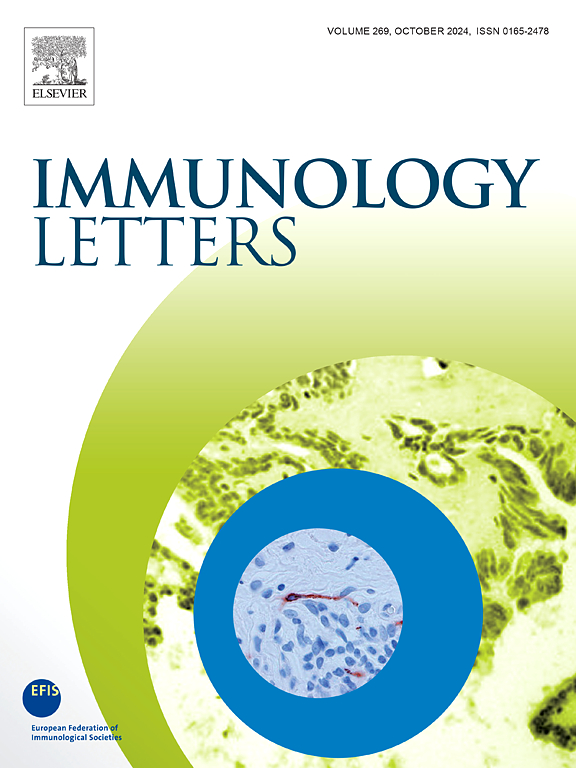人类角化细胞暴露于热带利什曼原虫临床菌株可导致寄生虫内化。
IF 2.8
4区 医学
Q3 IMMUNOLOGY
引用次数: 0
摘要
热带利什曼原虫引起的皮肤利什曼病(CL)是摩洛哥的一个公共卫生负担。越来越多的临床多态性对其正确的诊断和治疗提出了挑战。虽然热带乳杆菌引起的CL的免疫发病机制已被证实,但角化细胞(一种关键的皮肤免疫细胞类型)在该病理中的作用从未被研究过。总的来说,角化细胞在皮肤接种后对利什曼原虫寄生虫的识别和早期免疫反应中起着至关重要的作用,通过产生早期细胞因子影响局部免疫反应,形成抗利什曼原虫免疫反应。此外,它们对每一种利什曼原虫的反应不同,影响疾病的结果,并帮助创造适合每种原虫的独特微环境,从而影响疾病的进展。在此,我们用摩洛哥临床菌株L. tropica和L. major体外感染人角质形成细胞HaCaT细胞系。通过流式细胞术和成像流式细胞术,我们发现角化细胞感染了利什曼原虫,并且它们内化了热带乳杆菌寄生虫。我们也报道了热带乳杆菌感染在角质形成细胞中的感染频率高于大乳杆菌。这些发现支持了角质形成细胞在皮肤感染早期的潜在参与。然而,需要进一步的研究来阐明它们在调节局部免疫反应中的作用。我们的研究是研究热带乳杆菌引起的皮肤恶性淋巴瘤过程中角质形成细胞参与的第一步,并为研究CL特异性皮肤免疫机制开辟了新的视角。本文章由计算机程序翻译,如有差异,请以英文原文为准。
Human keratinocytes exposed to a clinical strain of Leishmania tropica can result in parasite internalization
Cutaneous Leishmaniasis (CL) due to Leishmania tropica is a public health burden in Morocco. The increasing clinical polymorphism challenges its proper diagnosis and treatment. Although the immunopathogenesis of CL due to L. tropica has been documented, the role of keratinocytes, a critical cell type in skin immunity, has never been investigated in this pathology. Overall, keratinocytes play a crucial role in the recognition and early immune response to Leishmania parasites upon skin inoculation, influencing the local immune response by producing early cytokines that shape anti-leishmanial immune responses. Moreover, they respond differently to each Leishmania species, influencing disease outcomes and helping create a unique microenvironment tailored to each species, thus affecting disease progression.
Herein, we have conducted in vitro infection of the human keratinocytes HaCaT cell line with Moroccan clinical strains of L. tropica and L. major. Through flow cytometry and imaging flow cytometry, we show that keratinocytes are infected with both Leishmania species and that they internalize L. tropica parasites. We also report that infection with L. tropica exhibits a higher infection frequency in keratinocytes compared to L. major. These findings support the potential involvement of keratinocytes in the early stages of cutaneous infection. However, further investigations are required to elucidate their role in modulating the local immune response. Our study is a first step in the investigation of keratinocytes involvement during CL due to L. tropica and opens new perspectives for research into CL-specific skin immune mechanisms.
求助全文
通过发布文献求助,成功后即可免费获取论文全文。
去求助
来源期刊

Immunology letters
医学-免疫学
CiteScore
7.60
自引率
0.00%
发文量
86
审稿时长
44 days
期刊介绍:
Immunology Letters provides a vehicle for the speedy publication of experimental papers, (mini)Reviews and Letters to the Editor addressing all aspects of molecular and cellular immunology. The essential criteria for publication will be clarity, experimental soundness and novelty. Results contradictory to current accepted thinking or ideas divergent from actual dogmas will be considered for publication provided that they are based on solid experimental findings.
Preference will be given to papers of immediate importance to other investigators, either by their experimental data, new ideas or new methodology. Scientific correspondence to the Editor-in-Chief related to the published papers may also be accepted provided that they are short and scientifically relevant to the papers mentioned, in order to provide a continuing forum for discussion.
 求助内容:
求助内容: 应助结果提醒方式:
应助结果提醒方式:


